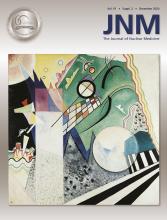Among the scientific accomplishments recorded in The Journal of Nuclear Medicine is Hal Anger’s groundbreaking contribution entitled, “Scintillation Camera with Multichannel Collimators” (1). In this article, Anger moves beyond the concept of pinhole imaging to an emerging, multiple–parallel-hole, concept for projecting photons onto an imaging screen because, in his words, “…for large gamma-ray emitting subjects, such as the brain or liver, collimators with large numbers of parallel holes…give the best combination of sensitivity and resolution.” This forward-looking move to a new and more efficient approach to collimating photons profoundly impacted the emerging field of radionuclide imaging; it expedited and, importantly, expanded the potential of nuclear medicine imaging for new clinical applications and likely accelerated the growth of the emerging field of nuclear medicine. Imaging the uptake and distribution of radionuclides in organs for therapeutic purposes had begun only about 15 years before Anger’s 1964 publication on parallel-hole collimators, when Benedict Cassen, a physicist at the UCLA Atomic Energy Project, demonstrated that nuclear imaging was not only feasible but also relevant for treating thyroid disease with radioiodine (2,3). Cassen’s rectilinear scanner—which, in his early studies, consisted of a motorized collimated crystal-based radiation detector that moved back and forth over a radionuclide-containing target organ such as the thyroid gland—produced an image readout or scan of an array of lines with dots of different intensities or densities, which was printed on paper or radiographic films. Envisioning a different concept of radionuclide imaging in which the entire organ could be imaged at once, Hal Anger, an electrical engineer at the Donner Laboratory at the University of California in Berkeley, pursued an approach in which photons originating from the thyroid gland pass through a pinhole and are projected onto an imaging screen. This screen consisted at first of photographic paper but was subsequently replaced by an initially 4-in-wide and later 11-in-wide sodium iodide scintillation detector crystal that Anger had coupled to a set of densely packed photomultiplier tubes (4–6). From the signal output of the set of photomultiplier tubes, and with an analog computer, Anger succeeded in using a novel centroiding technique to accurately localize where on the detector crystal the scintillation or light flash had occurred (7). Anger’s invention of this centroiding technique, known today as Anger logic, proved to be the key for γ-camera imaging and continues to be used in modern radionuclide imaging systems.
Anger’s 1964 publication in The Journal of Nuclear Medicine is a testimony to his impressive analytic mind (1). He emphasizes distinct advantages of parallel-hole collimators, such as the “one-to-one size relationship between the subject and the image produced in the scintillator,” the fact that the image “size is independent of the distance between the subject and the collimator,” and the “uniform ‘depth response’.” Importantly, as Anger states, “the best combination of sensitivity and resolution for a given subject and radionuclide” can be achieved only through an optimal method of photon collimation, an objective that motivated the research presented in this publication. Anger describes a variety of collimator designs, carefully explores the performance properties of individual collimator components (e.g., the number, diameter, and shapes of collimator holes; the density of packing holes; and the thickness of septa), and derives formulas for a series of radionuclide-specific collimator designs of optimal sensitivity and spatial resolution. The paper underscores the importance of different collimator designs for different types of medical imaging by showing images of the liver and kidneys, for example, as well sets of serially acquired dynamic images. As if to summarize his findings, he points out and predicts that the “resulting greater speed with which pictures can be taken is a decided advantage in clinical situations. Several different views can be taken if desired, and the examination can still be completed in a relatively short time.” An interesting sideswipe at Cassen’s rectilinear scanner (still widely used at the time) can be seen in Anger’s comment that even when used with high-energy photons, the overall sensitivity of his scintillation camera is “still considerably higher than that of focused-collimator mechanical scanners.”
Looking back at the tremendous impact of Anger’s work on nuclear medicine imaging, it is not surprising that the paper received more citations than any other publication in The Journal of Nuclear Medicine in the 1960s. The author had indeed correctly foreseen the lasting impact of Anger logic and parallel-hole collimation on state-of-the-art radionuclide imaging devices, including whole-body imaging systems and tomographic imaging with SPECT.
DISCLOSURE
No potential conflict of interest relevant to this article was reported.
Acknowledgments
I thank Susan Nath for her editorial assistance in preparing this commentary.
- © 2020 by the Society of Nuclear Medicine and Molecular Imaging.
REFERENCES
- Received for publication May 1, 2020.
- Accepted for publication May 7, 2020.







